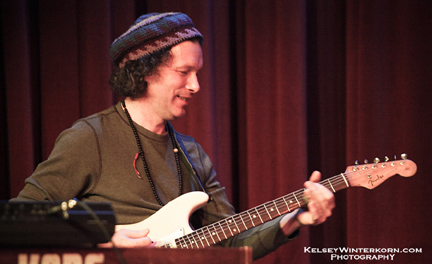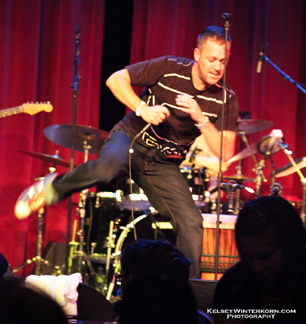
All Photos by Kelsey Winterkorn, (Kelseywinterkorn.com)
Chris Berry and CB-3 just wrapped up a tour with guest guitarist Steve Kimock. Berry, who has busied himself with Panjea and CB-3 as of late, was schooled for years in Africa, specifically Zimbawe, where he mastered the traditional finger piano instrument, the mbira. Having had sold over a million albums in Africa by the turn of the millennium, he brought this unique blend of African, World, and Jam music to the US. Performing on what may be the world’s first and only electric mbira, the sound he has developed is so unique and specialized that there is no other like it.
Working with members of the Brazilian Girls, Aaron Johnston (drums) and Jesse Murphy (bass, keyboards), CB-3 is African-flavored world music with a strong songwriting core, and notable electronic influence. I had some questions about what to expect from such an eclectic group, and the role of Kimock in the mix. Fans of Berry and Kimock take note: this weekend the two musicians are heading out to Hawaii for Tropical Jam 5.

CB-3 with Peter Apfelbaum and Steve Kimock, Yoshi’s Jazz Club, SF, CA – 2/27/10
STEVE KIMOCK
SM: You’ve collaborated throughout your career with so many different musicians, what has your experience been playing with Chris Berry and CB3.
SK: It was funny going in, because as I was told it’s kind of improvisational and kind of African, and how Chris plays the mbira, but it was just supposed to be music that just grooved. And so I was like, “Ok, cool.” I received no material, I had nothing, I was under the impression that it was going into a very free, open form type of situation. And I get to the gig, and they have these incredible arrangements and vocal harmonies, and I was kind of ill prepared. Like, “ Oh no….!”
It was extraordinarily cooler and more together than the description that I understood. So I scrambled around for a while, kind of like a chicken with its head cut off (laughs), trying not to wreck it. Chris’s rhythm section is just astounding. You have this guy playing the bass with one hand and the keyboard with the other (Jesse Murphy), they have all this stuff going on. Honestly I was totally unprepared for how cool it was. And I had to kind of had to grab Chris by the shirt and go, “Show me quick!” So he showed me a bunch of the basic groove stuff that he was doing on the Mbira. I do have some experience with Afro-Pop and some traditional African grooves, so I’m was a little familiar. But once he showed me the basics I was like, “Oh…I get it.”

SM: What do you do when you’re thrown on stage and are basically put in the position that you found yourself in?
SK: Well it’s like being a boxer, and you’ve trained for months and months and you’re sitting in your corner of the ring and at the last minute your opponent’s pulled for some reason and they’ve stuck in a southpaw. So for the first few rounds you get beat up a little bit, and you scramble.(laughs) And if you’re not flexible you’re going to get your ass kicked till you figure it out. But my role in this gig is not so much about knowing exactly what going on but kind of of keepin’ my head up, and keep trying to react in some way that extends the music. In some way it’s like sparring.
SM: So would you characterize CB3 as a form of jazz?
SK: I’m a big fan of jazz, a real big fan. At age 16, I got turned onto, A Love Supreme. Which is just an epic record. I started every day of my life for I don’t know how many years listening to this. And it has certainly influenced me. There is a richly defined and pervasive attitude as to what jazz is. On the other hand for me I see just the small band, improvisational thing as jazz, from Miles Davis’s band and The Grateful Dead. Between the two there are some differences in the musical vocabulary, but overall the mechanics, how the ensemble works and they react to each other and listening to each other is the same.
SM: What is your experience, your take on playing in a band with the mbira, more specifically, what may be the world’s only electric mbira?
SK: Before playing with CB3 I had a short and superficial understanding of the mbira. It’s kind of scary, the dude has done something that no one else has done. It has a very unique sound.
*****

CHRIS BERRY
SM: So tell us a little bit about your current lineup in CB3?
CB: The current lineup is with members of the Brazilian Girls, it’s with Aaron Johnston (drummer) and with Jesse Murphy (bassist), basically they were the writing force behind the Brazilian Girls.
We keep it small, it’s Chris Berry Trio, so it’s drums, bass, Electric mbira and djembe, and myself singing. And we keep an open space so we can feature some of our favorite artists. We’re just starting out, and we’ve done a tour featuring Michael Kang, we did a tour featuring Peter Apfelbaum and now we’re doing this tour featuring Steve Kimock. So we kind of leave the guitar position or the keyboard position open, we have the arrangement of the songs set, and then we have open areas where we get have a musician come in and tear it up in the open spaces. It could be the Chris Berry Trio featuring special guests. And of course this tour we feature Steve Kimock, where you’re going to hear the same songs, but they are always going to be colored differently because of that special guest.
SM: Is it always going to be Chris Berry Trio songs, or do you showcase some of the songs of the guest musicians as well?
CB: No, that’s our strong suit. If you look at Panjea songs or Brazilian Girls songs, we’re all strong songwriters, I won a Grammy a two years ago, The Brazilian Girls were nominated for a Grammy last year and that’s where our strength is, our songwriting. So the songs are set, they will always be CB3 songs, but they’re going to sound a little different with the guest artist on board.
SM: How do you feel about being embraced by the jamband scene and why do you think that is?
CB: I think people didn’t know what to do with me over here, I think the jamband scene was the only scene that was open-minded enough to be able to embrace us, because I didn’t really fit into any particular genre. My music is not really African, it’s not really American, it’s not really funk, it’s just a lot of different things. And the jamband community was the only community that was open minded enough to hear good music and go, “We don’t care how you want to be branded but it’s good music.” And I’ve heard this a lot from the jamband community. It’s good music, and it’s jammy because in Africa music is really jammy and there are so many sections that open up to improvisation. That’s kind of the nature of African music, and the nature of jam music, so it crossed over. And when we play live there are so many sections that are open for us to just jam out and tear it up, whereas in other types of music, pop, music there isn’t that much freedom.
SM: To your mind, what else does the CB3 bring into the mix that is distinctive?
CB: Well, the cool thing about CB3 is that working with the Brazilian Girls we do bring in that electronic sound. They have that electronic thing they bring that to the table. It a fusion of the ancient music, with the brand new cutting edge technology of electronic music. That’s actually what we’ve created, a blend of the ancient and the new.


No Comments comments associated with this post